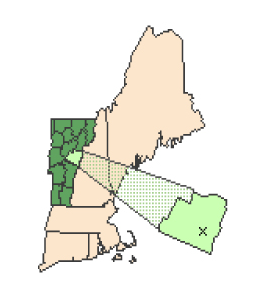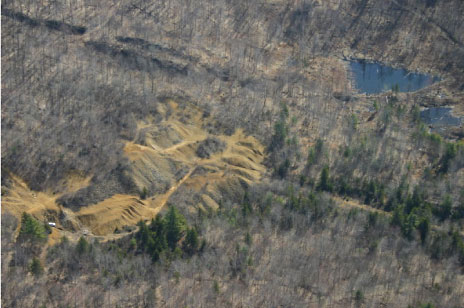Case Study as part of a Web-based
Technical and Regulatory Guidance
Ely Copper Mine Site
Orange County, Vermont
1. Site Information
1.1 Contacts
Linda Elliott
Vermont Department of Environmental Conservation
Waste Management Division
Site Management Section
Waterbury State Office Complex
One South Building
103 South Main Street
Waterbury, VT 05671-0401
E-mail: [email protected]
Telephone: 802-241-3897
1.2 Name, Location,
and Description
The Ely Copper Mine is an abandoned copper mine located in a rural setting
off Beanville Road in Vershire, Orange County, Vermont (Figure 1-1). The
property encompasses approximately 1800 acres, about 27–350 acres of which
were used for copper mining activities 1821–1920 (Figure 1-2). Since 1920,
the mining operation has been inactive except for the removal of “dump ore”
from the property 1949–1950. Currently, the property is owned by Ely Mine
Forest Inc. and Green Crow Corporation. Portions of the property are managed
for commercial timberland. Affected media include soil, surface water and
sediment, and groundwater.

Figure 1-1. Ely Copper Mine location site map.

Figure 1-2. Aerial photograph of Ely Copper Mine site.
Past mining operations at the site included cobbing, roasting, and smelting the ore. The ore mined at the site averaged 3.3% copper. The ore was fragmented, or cobbed, to a product containing approximately 7% copper. Ultimately, the ore was smelted to produce a copper matte, which is a molten mixture of copper/iron sulfide material. In 1918, a flotation mill was built to extract additional copper from existing waste piles on the property. In 10 months, the extraction operation generated 19,000 tons of waste material averaging 1.34% copper. According to the volume calculation by the Bureau of Mines, copper mining production generated approximately 100,000 tons of tailings and slag on the property.
The mining operation extends from Ely Brook and continues up a steep slope towards a ridge. Piles of waste rock, smelter waste, and tailings that were generated from mining processes are located on the property. The smelter waste pile is located along the southern section of the property and covers approximately 4.3 acres. This pile consists of slag that exhibits a metallic luster. The tailings pile is located at the central section of the property and covers approximately 10.8 acres. This pile is composed of a fine-grained material, reddish-brown in color at the surface. Seeps were noted along the western section of the tailings pile. Two intermittent mine drainage streams drain the property. Mine drainage stream A flows adjacent to the west side of the tailings pile; mine drainage stream B flows over the tailings pile. The mine drainage stream beds are stained orange-reddish brown due to surface water runoff from the tailings pile on the property.
Remnants of stone works from past mining operations are located throughout the property. There is minimal vegetation in the areas of the waste rock pile, tailings pile, and the smelter waste pile on the property. Woodlands surround the mine property. Downed trees and areas dammed by beaver activities were evident in the Beaver Pond section of the property. The Ely Copper Mine has no restrictive barriers to pedestrian access. During a November 1999 field event, a gate that previously restricted vehicular entry to the access road was observed to be unlocked, damaged, and in an open position. In addition, several people were noted using the property for various types of recreation (hunting, hiking, recreational vehicle use). A gun club has permission to access the property for hunting.
The Ely Copper Mine site was placed on the National Priorities List on September 13, 2001. The primary contaminants at the site include copper and acidity with iron as a secondary contaminant. EPA has initiated the remedial investigation and feasibility study for the site. Investigations continued into 2008 and are expected to be completed in 2010. A series of reports summarizing the investigation activities to date will be released in 2009. A cleanup plan is expected to be proposed in 2010 or 2011.
2. Remedial Action and Technologies
The Bureau of Mines conducted an experimental
biological treatment system of the mine drainage at Ely Copper Mine in 1995.
A portion of the drainage stream was passively treated with manure, compost,
wood chips, and limestone, which served as a bacterial sulfate-reduction
system to precipitate metals. This treatment system consisted of five 32-gallon
barrels in series that intercepted flow in the mine drainage stream. In addition,
water samples from the system and two mine drainage streams
were collected monthly. In 1995, the treatment system continued to remove
metals and sulfate, add alkalinity, and increase the pH of the mine drainage.
However, water quality data were inconsistent because
of the lack of regular monitoring and maintenance of the system.
3. Performance
Site cleanup goals are based on the mitigation of ecological risk. Primary
concern is impact to surface water bodies and secondarily environmental
concerns such as endangered bats and other wildlife, plus lack of vegetative
cover for affected areas. Human health risks are also being evaluated.
The overall performance criteria goals are to neutralize pH and reduce bioavailability of metals. The success of plant growth on treated/neutralized tailings was monitored to evaluate the effectiveness. The bench-scale phase was conducted during a three-month growing season. Results were positive. The trials with Omya tailings treatments did support vegetative growth, whereas nothing grew in the untreated controls.
4. Costs
No information available.
5. Regulatory Challenges
Leaving large quantities of solid mine waste in place on site present issues
with long-term stewardship (LTS). LTS can include the use of institutional
controls to ensure that the cap is maintained. Restricting site access or
allowing continued use of the site for recreational or industrial purposes
poses a unique set of challenges. Due to the size of these mine waste sites,
it is often not feasible to fence or otherwise block access to the site.
Many members of the community do not recognize that the sites are private
property, and trespassing is frequent. Resources are not available to police
for enforcing trespassing laws. Monitoring and maintenance become the primary
regulatory challenge in these instances.
6. Stakeholder Challenges
A public comment period is needed for implementation of full-scale remediation.
A citizens’ group concerned about Omya’s impacts is likely to liaison with
the copper mine site citizens’ groups to raise concerns about possible contaminants
in the Omya tailings.
7. Other Challenges and Lessons
Learned
None reported.
8. References
U.S. Environmental Protection Agency. n.d. “Ely Copper Mine, Vershire,
Vermont.” http://yosemite.epa.gov/r1/npl_pad.nsf/51dc4f173ceef51d85256adf004c7ec8/1bb22e27742b914785256aca00529857!
OpenDocument&Highlight=0,ely.
